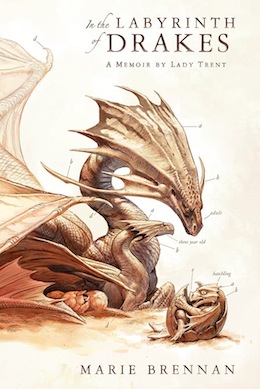This is the fourth of the Lady Trent memoirs, and it’s only fair to note that I’ve been in love — platonic love, but deeply felt — with Dame Isabella (as she is at the beginning of In the Labyrinth of Drakes) since the first chapters of A Natural History of Dragons. The wry, retrospective quality of the first-person narrative and the quasi-Victorian style has an enormous appeal, and so too does the fact that at their heart, these are novels about science, about the love of discovery and the joy and struggle of intellectual work.
I’m a sucker for that kind of thing, and considering how often fantasy tends towards suspicion of science and denial of progress? It’s all the more refreshing to find a series that does the opposite.
Some spoilers.
Isabella is one of the foremost dragon naturalists of her time, though because she is a woman, she has difficulties in her chosen profession that her male peers do not. When the opportunity arises for her, along with her friend and colleague Tom Wilker, to take charge of the Royal Scirling Army’s dragon-breeding project in the allied nation of Akhia, Isabella’s eager to get to work. Not only for the scientific possibilities, but because now that dragonbone can be preserved, its lightweight properties have made it a military resource, and Isabella knows that if dragons cannot be bred, they’ll be hunted to extinction. The desert drakes of Akhia are their best opportunity.
One of the most delightful things about the Memoirs of Lady Trent series is the style and, well, breadth, of the travelogue: Isabella goes to the most interesting new places to study dragons. Akhia, with its deserts and its caliph, its desert tribes who maintain connections to the city and its social and political arrangements, puts the reader in mind of 19th-century North Africa or the Arabian peninsula. The landscape of In the Labyrinth of Drakes, like its predecessors, is a character in its own right, much as the different breeds of dragon are. (They are perhaps a little more well-rounded characters than Isabella’s brother Andrew, who seems to me to be a little thinly sketched in his appearances here.)
Isabella being Isabella, though, dragons and science aren’t her only concerns. The presence of an old and unexpected friend — Suhail, whom readers will remember as the enthusiast in Draconean archaeology and antiquity from The Voyage of the Basilisk — poses problems for Isabella’s reputation and for her relationship with the Akhian sponsors of the dragon-breeding project. And it turns out that Scirling’s enemies are out to sabotage the project, leading first to Isabella’s kidnapping while she’s conducting in the desert — a kidnapping eventually foiled with the assistance of Suhail, in an exploit that finds itself cast in a rather romantic light — and to the risk of poisoning for both Isabella and her captive dragons.
Isabella’s relationship with Suhail — as friends, as equals, as people romantically interested in each other where their respective socio-cultural circumstances conspire against a romantic attachment — plays a significant role in Labyrinth of Drakes. How it works out… well, let’s just say that Lady Trent did not, as I’d been half-expecting since A Natural History of Dragons, marry into her eventual title. Matters turn out sweet and touchingly, in fact, before the pair takes another research trip out into the desert, and into the titular Labyrinth of Drakes, a dangerous maze in the desert filled with Draconean ruins. There Isabella and Suhail make a discovery of importance both to dragon naturalists, and to archaeologists like Suhail.
As narrative climaxes go, it’s pretty great.
In the Labyrinth of Drakes has the feel more of a picaresque novel than a more traditional narrative arc. With its measured pace and a tension that lies more in scientific discovery and interpersonal relationships than external threats (though it has some of those as well, naturally), it may not be everyone’s cup of tea. But for me, the combination of these elements with Isabella’s inimitable voice and striking character makes Labyrinth of Drakes practically a perfect read: equal parts soothing and stimulating. Personally, I could read about Isabella’s adventures forever, and I hope there are many more Memoirs to come.
In the Labyrinth of Drakes is available now from Tor Books.
Read an excerpt from the novel here on Tor.com
Liz Bourke is a cranky person who reads books. She has recently completed a doctoral dissertation in Classics at Trinity College, Dublin. Find her at her blog. Or her Twitter.










